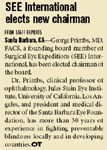Article
LHON can lead to devastating vision loss in carriers
Fort Lauderdale, FL—A study of a large pedigree of Leber's hereditary optic neuropathy (LHON) revealed two family members who were asymptomatic carriers but nevertheless had subclinical fundus and psychophysical impairments. After being followed for years, status in both patients converted from carrier to affected.
Fort Lauderdale, FL-A study of a large pedigree of Leber's hereditary optic neuropathy (LHON) revealed two family members who were asymptomatic carriers but nevertheless had subclinical fundus and psychophysical impairments. After being followed for years, status in both patients converted from carrier to affected.

The study of this pedigree began in October 2001, and the family members underwent yearly examinations thereafter in rural Brazil. All of the family members underwent extensive examination that included visual field testing, fundus photography, color vision testing, contrast sensitivity testing, electroretinograms, visual evoked responses, and Heidelberg retinal tomography, according to Alfredo A. Sadun, MD, PhD, who reported the findings at the annual meeting of the Association for Research in Vision and Ophthalmology.
In October 2002, there were optic disc changes, a slight decrease in color vision in one eye, and subtle changes in the visual fields; the visual acuity (VA) was 20/20 with no visual complaints.
In February 2004, the patient presented with visual problems in the left eye, and the VA decreased to 20/100; the VA in the right eye remained 20/20. Nine months later the patient lost vision in the right eye, according to Dr. Sadun, the Thornton Chair and Professor of Ophthalmology at the Doheny Eye Institute, Keck School of Medicine/University of Southern California, Los Angeles.
The second case
Case 2 was that of a 44-year-old man who, like the previous patient, had no visual complaints and very subtle subclinical changes during the first examination. There was prepapillary nerve fiber layer swelling, microangiopathy, and suggestions of a scotoma.
Dr. Sadun pointed out that in this case the investigators also found a very high level of neuron-specific enolase (17 µg per ml; normal < 5 µg per ml). This patient smoked and drank alcohol heavily (more than 10 drinks of hard alcohol daily), which are important environmental risk factors for development of LHON. In October 2002, the findings were still normal except for microangiopathy and swellings of the nerve fiber layer at the edge of the optic disc. The telangiectatic blood vessels disappeared in some places. About 18 months later, the VA in the left eye was 20/60 and 20/40 in the right eye, and the color vision was slightly impaired. The VA rapidly deteriorated to legal blindness bilaterally in about 2 to 3 weeks. As in case 1, the nerve fiber layer changes preceded the visual loss.
Dr. Sadun emphasized that in both cases these very subtle changes may be sentinel markers of devastating visual loss to come.
"We found two members of this large LHON pedigree were clearly asymptomatic carriers but had reliable though subtle impairments on fundus and psychophysical assessments. These changes built up over time and along with the elevated neuron-specific enolase level might predict that the subacute condition would convert from carrier status to affected status," Dr. Sadun commented.
He also pointed out some structure-function kinetic incongruities were present in these patients. That is, the patients had defects in the nerve fiber layer that were out of proportion to the visual deficits.
Newsletter
Don’t miss out—get Ophthalmology Times updates on the latest clinical advancements and expert interviews, straight to your inbox.




